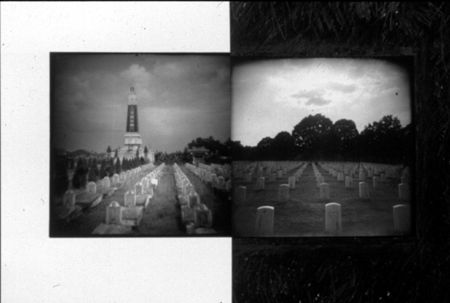Columbia City artist Tom Hubbard is one of those people who look exactly like who they are — like the female dancer whose ponytail, leotard top, jeans and lithe figure signal her profession or the college English professor with the blue, button-down chambray shirt and corduroy jacket. Stereotypical perhaps, but true nonetheless. The 40-ish Hubbard, a successful graphic designer and ceramicist, provides clues to his avocation via his crisp, collared, cobalt blue rayon shirt that peaks out from behind a black zippered jacket and accompanying black pants and shoes. His neatly trimmed black hair and goatee are balanced with stylish elliptical black eye glass frames. Nothing fuzzy or awry here. Only a distinct pattern, as in a Mondrian painting. Even his speech and delivery seem flawless, without traces of “ahs” or “ums”.
Samples of his graphic output — corporate logos, merchandise brochures and college catalogs — reveal his attention to pictorial placement and typographic delivery, all with the aplomb of a pro worthy of the several awards he has garnered over the years. His raku-fired ceramic pieces currently on view at the University of Saint Francis depart only in their medium from his “exacto” precision of the arranged page.
The real focus here is Hubbard’s installation Semper Fidelis: How I Met My Father, currently on view at the upstairs gallery of the Fort Wayne Museum of Art. The exhibition, which features some 14 photo/graphic constructions and 17 raku ceramic vessels encrusted with embedded type messages and Polaroid images, opened last December and will continue its run through February 22.
Hubbard’s journey began a few years ago when his son turned two, and the artist sought to discover his own father who he lost at the same age when he was killed while serving in the Marines in Viet Nam in 1966.
“This body of work is the result of a personal journey I have taken to come to know my father,” explained Hubbard. “Using Marine field reports as a guide I was able to reconstruct my father’s tour of duty, and over a five-week period in the summer of 2000 I visited battlefields, the DMZ and the places my father served, including the village of Kim Lien where he and three other Marines were killed.”
Integrating passages from his father’s letters home, maps, photographs and some sobering scraps of Marine and Department of Defense documents, Hubbard filled several journals which became the foundation for the work. Collating his talents in graphic design, photography and ceramics, the Indiana University graduate forged the disciplines into an at times haunting homage that instructs and celebrates simultaneously.
In the case of the photo diptychs, Hubbard’s graphic background serves him best. Juxtaposed black and white images are framed in what appear to be aluminum or tin frames made in Vietnam that resemble the old 35-millimeter slide cases. Mounted in front are etched glass or Plexiglas captions containing excerpts of his dad’s letters or descriptive text gleaned from military records.
Hubbard described the diptychs as “images (which) draw parallels between the American and Vietnamese traditions of remembering the war and honoring the dead … These pieces, while less emotionally charged, … set the tone and provide a broader context for the installation.”
Because of his obvious strengths in typography and knowledge of solving visual communication challenges, Hubbard does sometimes run the risk of producing work that seems almost too clean, too formal and overly polished, which causes it to lean toward alienation. At the same time he somehow manages to avoid becoming maudlin or sentimental while conveying what is ultimately a searing personal statement of realization and acceptance.
Hubbard describes the ceramic vessels as being loosely based on military bunkers and artillery shells. “Made from roughly hewn terra cotta slabs with text stamped into the surface, these pieces feel as if they have emerged from the battlefields of Vietnam and represent the physical loss of my father…” he explained in his written artist’s statement.
Interestingly, the narrative typography was actually composed and formatted on a computer, then sent off to be fashioned as magnesium letterpress plates which were used by the artist to physically stamp the ceramic artifacts.
Like many artists, Hubbard isn’t comfortable talking about his work; he feels it should speak for itself. Yet, because of the subject matter, he has been forced to talk about the history of the project to provide a context for the viewer.
“This installation is not a political statement about the war in Vietnam,” Hubbard said. “It is a statement about the impact of war and personal loss (a subject or renewed interest vis-à-vis Iraq, etc., he acknowledges) … My hope is that by sharing my story I can help others who have suffered a similar loss and provide support to the veterans who served in Vietnam. This body of work is not simply a memorial to my father, it is an expression of the pain and the personal insight of coming to terms with the loss of my father. It does not merely represent my relationship with my father; it is my relationship with him.”
Like the quest of so many family members, friends and spouses of lost combatants (more than 58,000 Americans and upwards of 2.5 million Vietnamese were killed in the 15-year-long conflict), Hubbard needed answers and closure. It turns out there is no happy ending here. He never found his dad, played catch or swapped stories with him. What he found were the artifacts of loss and war. There are no promises of reclamation, no meeting on the other side or beyond, just the realities of a KIA. How do you render that?
Maya Lin did it with her granite wall in Washington, and, as we write, jurors are deciding an appropriate memorial at the site of World Trade Center.
Hubbard’s attempts are worthy of our attention.
 Submit Your Event
Submit Your Event
